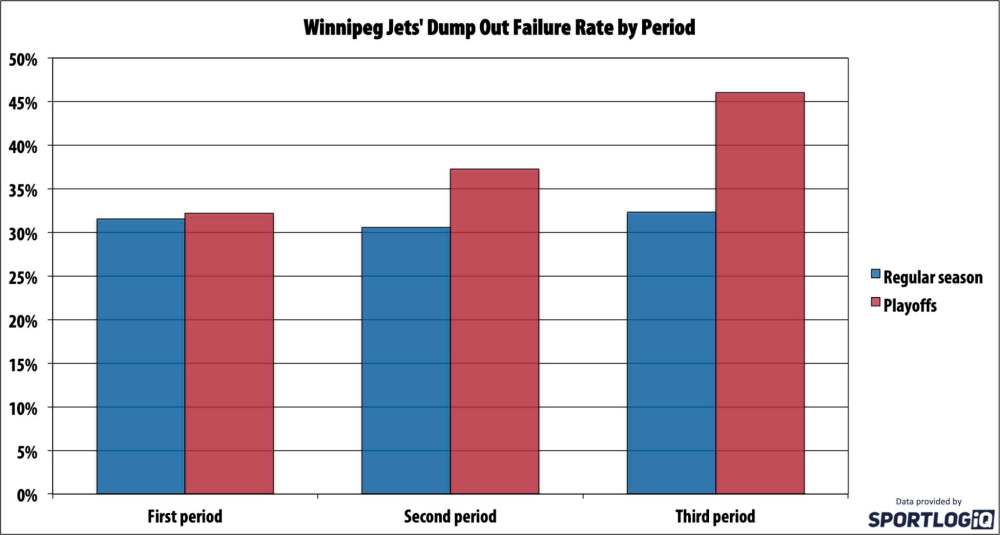Defensive zone turnovers continue to haunt Jets
Advertisement
Read this article for free:
or
Already have an account? Log in here »
To continue reading, please subscribe:
Monthly Digital Subscription
$0 for the first 4 weeks*
- Enjoy unlimited reading on winnipegfreepress.com
- Read the E-Edition, our digital replica newspaper
- Access News Break, our award-winning app
- Play interactive puzzles
*No charge for 4 weeks then price increases to the regular rate of $19.00 plus GST every four weeks. Offer available to new and qualified returning subscribers only. Cancel any time.
Monthly Digital Subscription
$4.75/week*
- Enjoy unlimited reading on winnipegfreepress.com
- Read the E-Edition, our digital replica newspaper
- Access News Break, our award-winning app
- Play interactive puzzles
*Billed as $19 plus GST every four weeks. Cancel any time.
To continue reading, please subscribe:
Add Free Press access to your Brandon Sun subscription for only an additional
$1 for the first 4 weeks*
*Your next subscription payment will increase by $1.00 and you will be charged $16.99 plus GST for four weeks. After four weeks, your payment will increase to $23.99 plus GST every four weeks.
Read unlimited articles for free today:
or
Already have an account? Log in here »
Hey there, time traveller!
This article was published 19/04/2019 (2427 days ago), so information in it may no longer be current.
The horrible way the Winnipeg Jets closed out the 2018-19 regular season and the much-more inspired play we’ve seen in the playoffs met in a calamitous Game 5 loss Thursday to the St. Louis Blues.
For two periods, the Jets put on a dominant showing: starting with a strong forecheck by Andrew Copp and a loose-puck recovery from Brandon Tanev that he immediately put on net to produce a rebound that bounced onto the stick of a perfectly positioned Adam Lowry who wired it home — all within 12 seconds of the first faceoff.
When Kevin Hayes scored on a drive to the net through traffic some 13 minutes later, it looked like it might develop into a blowout. The home crowd at Bell MTS Place was roaring and the Jets were amped and playing great, but they couldn’t get another one by Blues goalie Jordan Binnington, despite several power-play opportunities.

In the third period, a familiar problem from the regular season returned, as the Blues scored on a power play of their own, followed by a breakdown off the rush where Oskar Sundqvist beat Jets defender Dustin Byfuglien one-on-one and slipped a pass through blue-liner Ben Chiarot to a streaking Brayden Schenn who tied the game.
Despite blowing the lead, things seemed relatively in control for the Jets until the dying seconds, when Jacob Trouba tried to eat the puck along the boards with too much time left on the clock. The puck was poked free, but Mark Scheifele wins a battle for it along the boards.
At this point everything is fine: the Jets have control of the puck in a position that isn’t dangerous. However, all Scheifele manages to do is a weak backhanded clearing attempt up the boards — which Blues forward Tyler Bozak reads perfectly and intercepts, sending a wild pass into the slot Jayden Schwartz whacked out of the air into the net to seal a comeback victory with just 15 seconds remaining.
Each goal was different, each one carried a bit of bad luck and different kinds of mistakes, but for the Jets, blowing third-period leads has been too common of an occurrence in the past few months.
The first thing to look at is defensive zone turnover rates separated by period, and while the Jets’ turnover rates are higher in the playoffs across all three, that shouldn’t be a surprise. The Blues are one of the better forechecking teams in the NHL, and facing them every night is going to be significantly tougher than facing an average NHL opponent.

What’s more interesting than the gap between playoff turnover rates and the regular season is while the Jets were relatively consistent handling the puck in their own zone in each period during the regular season, there’s a lot of variance in the playoffs.
Lots of things factor into turnovers rates, the score being chief among them, but the Jets seem to play relatively safe with the puck in their own end in the first period, and struggle quite a bit more in the second and third periods, especially the second.
More turnovers makes them more susceptible to longer offensive zone possessions by the Blues, making it easier to exert pressure and create plays where luck becomes a factor in scoring goals.
In Game 5, the Jets posted the worst defensive zone turnover rate of any single period, of any team, in the entire playoffs thus far, with 25 per cent of their possessions leading to a turnover in their own zone. Only one of the three goals against was a direct result of that sloppy play, but that’s all it took to change the game’s fortune.
It’s easy to say the Jets are turning the puck over too often, but to identify the problem properly we have to figure out where it’s happening and why.
The biggest problem the Jets have with defensive zone turnovers directly related to the game-winner Thursday.
In the regular season, the Jets failed on more of their dump-out attempts in the third period than in the first or second, and it hurt them a lot at the end of the season. But over the course of 82 games, the difference isn’t that large, just one percentage point worse than they were in the first period.
In the playoffs, the Jets get progressively worse at clearing their own zone as time goes on, until we get to the third period, where they’re failing on nearly half of them.
The Blues have clearly exploited a panicky tendency the Jets players have to go up the wall — there’s a reason Bozak was exactly where the puck went on Scheifele’s failed clearing attempt.
On balance, taking all metrics into account, outside of the crease the Jets have been the better team for the last four games, but a lack of focus in the final frame in their own zone, and Binnington standing on his head, has made this series a tough one.
The Jets will have to adjust to the Blues forecheck, consistently stopping their clearing attempts — if they’re smart, they might be able to take advantage of some assumptions the Blues make to shut those lanes down.
Andrew Berkshire is a hockey writer specializing in data-driven analysis of the game
History
Updated on Friday, April 19, 2019 6:29 PM CDT: Removes thumbnail










